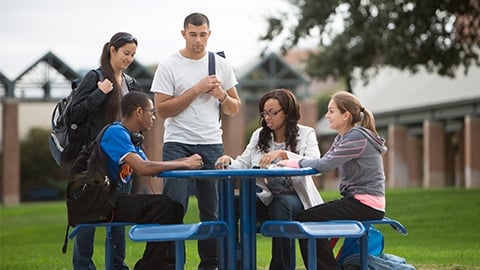You have /5 articles left.
Sign up for a free account or log in.

St. Philip's College
A program that began as a unique initiative to eliminate “summer melt” has also led to increases in the number of students returning to campus and taking on larger course loads to get to graduation quicker.
The Alamo Colleges District is two years into its Summer Momentum Program, which officially started in 2017 and provides scholarships for free summer courses at its system of five Texas community colleges to students who earned at least 18 credit hours in the preceding fall and spring. Students who carry between 18- and 24-credit course loads can receive up to six free credit hours in the subsequent summer.
The program was created to counter what some academics call “summer melt,” which occurs when students who were enrolled in the spring don't return for the fall semester, and to encourage more students to attend full-time. So far, more than 7,000 Alamo students, about 34 percent of the total student population, have participated in the program each year, according to the district's data. The free courses cost the system about $3 million a year.
“We did see higher levels of persistence and we saw slightly higher grade point averages as they persisted compared to those who did not take advantage of the summer momentum program,” said Diane Snyder, Alamo’s vice chancellor for finance and administration and interim vice chancellor for economic and work-force development.
At San Antonio College, 42.5 percent of students in the summer program were enrolled during the following fall semester in 2017 compared to 28 percent of students who did not receive the scholarship. Northwest Vista College also saw significant gains in persistence in the first year of the program, with 63.6 percent of students in the summer program enrolling the subsequent fall compared to 43.2 percent of their peers who did not participate in the summer program.
The system also saw students taking more classes in the summer than the scholarships covered. For example, of the more than 3,700 students who qualified for three free credits in the summer, about two-thirds of them enrolled in more credit hours. Among those who qualified for six free credit hours -- about 3,800 students -- about one-third of them enrolled in more than six credits. This year for the first time, students could choose to use summer Pell Grant funding to cover the costs of courses that weren't covered by the scholarship.
Davis Jenkins, a senior research associate with the Community College Research Center at Teachers College at Columbia University, said the numbers indicate a consciousness among program administrators and participating students about the time and work it takes to earn a degree.
“Most community college students nationally don’t have a plan or know how far they have to go, or even know they need to get through quickly,” he said.
Jenkins said the increases Alamo is seeing reflect the work the district is doing as part of its guided pathways effort, which helps students identify the credits they have, the credits they need and how long it will take them to graduate.
“Colleges are increasing their full-time enrollment even in some cases where head-count enrollment is declining because students are taking more courses,” he said. “And they’re able to take more courses because every student is on a plan.”
Despite the early successes of the summer initiative, some challenges remain.
“We had thought perhaps in the second summer we’d see more students taking advantage of the program, and so far, we’re seeing about the same,” Snyder said. “So we need to peel that onion a little more.”
About 50 percent of eligible students who earned 18 to 24 credits over the fall and spring semesters have participated in the program each year. In 2017, more than 14,200 students qualified for the scholarship, and in 2018, 14,290 students were eligible for the program. The number of students participating in the program has remained relatively the same since it began. A total of 7,256 students participated in 2017, but this past summer only 7,225 students received the scholarship.
District officials suspect that some students who are eligible for the scholarship may graduate from Alamo before they can take advantage of it, or they may not be interested in taking more courses in the summer regardless of whether it’s free or not, Snyder said.
The colleges plan to dig into the data to understand why eligible students are not enrolling in the free courses. The system also plans to follow the students for longer than two summers to see whether they graduate or transfer, but so far, it’s too early for that level of detail, Snyder said.
There have been several popular initiatives around the country to help students increase the number of courses they take each year so they can graduate sooner. For instance, Complete College America, a nonprofit organization, promotes a 15 to Finish initiative that encourages students to pursue at least 15 credits per semester. And California has a new program that awards qualified community college students up to $4,000 a year if they take 15 credits or more per semester. Meanwhile, in Ohio, Marion Technical College has a new program that awards students a tuition-free second year -- or 35 credit hours free -- if they complete at least 30 hours of college-level courses in the first year while earning a 2.5 grade point average.
The next step for Alamo will be examining the data to determine who is taking advantage of the program and whether they’re closing racial equity gaps, Jenkins said. He noted that the gains at Palo Alto College are significant because it’s also a Hispanic-serving institution.
“This could be big in community colleges,” he said. “All of the colleges over all are improving and that’s really impressive … but how is this benefiting older students, low-income students and students of color?”








